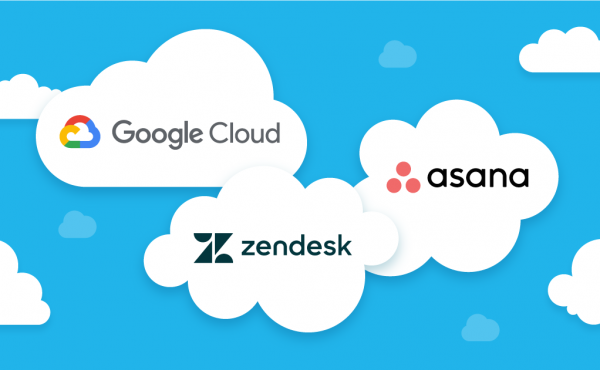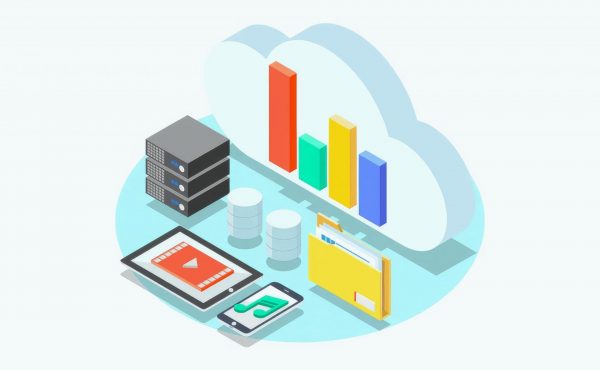The use of cloud technology under martial law in the financial sector
No Pun Intended: Cloud Adoption in Financial Services Is Soaring
- Financial Services: The Distinction
- Cloud Adoption in Financial Services: What Value Does It Bring to the Table?

- The Common Ground
- An Unclouded Path to the Cloud

- About Us

In its March 2024 report, multi-national consulting conglomerate McKinsey named “cloud and edge computing” as the most heavily pursued trend by firms providing banking and financial services, with the backing of more than five-sixths of respondents.
This only seems logical given the pandemic-induced acceleration of cloud roll-out among banking institutions. According to Accenture’s data referenced by Forbes, in 2022, 63% of market players intended to offload their mainframe infrastructure onto a public cloud, while 31% and 6% sought hybrid and private environments, respectively.
In this article, we gauge the state of cloud adoption in financial services, explore the areas where it is poised to yield the highest returns, and overview some of the most applicable case studies.
Financial Services: The Distinction
In the cloud-centered context, financial services firms fall into two primary categories — conventional and contemporary. “Conventional” providers include but are not limited to regular banks, investment banks, insurers, lenders, money transfer businesses (MTBs), and stock exchange operators. Historically, these types of institutions have been around ever since the first monetary relations were forged. The only thing changed is the very way they function, so for them, going cloud presents just another evolutionary step. As a rule of thumb, these actors take up the right side of Rogers’ bell curve applied to cloud adoption in financial services. This naturally happens due to the complexity of internal processes and heightened regulatory scrutiny.
On the other hand, “contemporary” providers are cloud-native, or financial services born in the cloud. This privilege allows them to be flexible in embracing innovation straight “out of the box.” The category includes direct (i.e., branchless or virtual) banks, various FinTech companies, blockchain networks that cryptocurrencies are built atop, and more. Such organizations do not need to experience a high degree of disruption as they are cloud-ready by design, meaning they often turn out to be innovators or early adopters. Contributing to this agility are lean managerial structures and electronic interactions with government bodies and agencies.
Cloud Adoption in Financial Services: What Value Does It Bring to the Table?
Now that we’ve defined the groups of providers, let’s take a closer look at the benefits of cloud computing in financial services.
Conventional Providers
When speaking of traditional market players, the first benefit that comes to mind is the ability to comply with stringent regulatory requirements. As world economies become ever more borderless, firms in the sector also lead market expansion initiatives, with each country having its own set of rules to follow — think of GDPR in the E.U. or CCPA in the U.S. As for the finance industry, the most demanding regimes are those revolving around anti-money laundering (AML) and anti-terrorist financing (ATF).
With the arrival and rapid advancement of artificial intelligence (AI) and sophisticated, tailored Google Cloud solutions, there is plenty to offer with regard to revamping existing AML and ATF policies. Having equipped the corporation’s dedicated Anti-Money Laundering AI, HSBC — Europe’s largest bank in terms of total assets — managed to increase the visibility into validated suspicious activities by 100% to 300%. Reduced OpEx was another outcome of the cloud integration, enabling the bank to eradicate six in ten false alarms.
At large, this became possible due to embedded machine learning (ML) capabilities, allowing financial institutions to build custom models trained on their own datasets, replacing the outdated, manual rules-based approach. Another discernible advantage of ML-linked cloud adoption in financial services is the ability to detect anomalies even if one’s data hasn’t been previously labeled, regardless of whether it is time-series or not.
To top it all off, with the help of the cloud — provided by Google Cloud Platform, or GCP for short (What is GCP?) — companies in finance can channel all of their compliance efforts into a single-pane-of-glass regulatory reporting platform, facilitating further communication with the relevant authorities and creating a verifiable audit trail through establishing a granular, commonality-based data foundation.
Contemporary Providers
In our opinion, customer identity verification and resilience are the two areas that can prove most beneficial for contemporary financial services providers. Take, for example, a bank that has no physical sites and only sits on a customer’s smartphone or tablet. In order to set up and administer the know-your-customer (KYC) procedures upon sign-up, such entities would need a way to securely obtain, store, and verify government-issued IDs, sending out approval or rejection notices afterward (learn more about conversational AI in banking). In some instances, a compliance officer would also need to hold a video interview with the prospective customer, and none of that could be possible without the underlying cloud infrastructure. Bundled with cloud-based IAM solutions, this approach contributes to the emergence of a cohesive, multi-faceted identity security landscape.
The same holds true for resilience. Let us switch to one of the most thought-provoking examples of late — distributed ledger technology (DLT), or blockchains. Typically, those run on top of a number of different nodes, which are machines participating in the consensus algorithm, validating transactions, and helping ensure that the entire network preserves its integrity. As you have probably already assumed, the vast majority (if not all) of those nodes are hosted and managed in the cloud. In the case of Ethereum, the second-largest digital asset chain in terms of market capitalization, this figure stands at 70%, according to a crypto news outlet Decrypt, underscoring the widespread cloud adoption in financial services that strive to assist the unbanked. We are not, however, talking solely about the infrastructure here; consumer-facing apps, such as wallets, explorers, and exchange platforms, also reside in the cloud. Most importantly, thanks to the cloud, projects all over the world are able to deliver on the core promise of blockchain: decentralization.
chances are, we’ve already solved them. Claim a free consultation →
The Common Ground
We believe that there are certain aspects of the cloud that both traditional and modern finance businesses can benefit from. One such aspect is customer experience (CX), which, when coupled with omnichannel personalization and configured properly, can positively impact a business’s bottom line in the long run.
Once again, the primary enabler in this space is generative artificial intelligence; McKinsey estimates that the technology is set to help banks rake in an extra US$200 billion to US$340 billion a year. With the help of Generative AI (GenAI), organizations can launch chatbot assistants and train them on voluminous arrays of data stemming from years of incoming queries, making sure that all the frequently asked questions are covered in as much detail as possible. Moreover, AI also enables financial services adopting the cloud to integrate their own knowledge base and implement continuous learning mechanisms, which means that advice coming from a chatbot always stays up to date. GenAI is not confined to the assistance setting, though; one can also leverage it for substantially broader purposes, such as capital market research or regulatory code modification analysis (see below).

Source: Google
In the meantime, omnichannel personalization — which can spur a 5% to 15% growth in income across the entire customer base, as per McKinsey — is the field where cloud products such as Customer Data Platform come into play. Due to built-in demand-sensing and intelligent segmentation, customer data platforms have become finance organizations’ indispensable tools for personalized communications. Additionally, one can find tailored promo recommendations within and ultimately deliver unforgettable, shareable experiences that can significantly enhance customer lifetime value (CLV). Last but not least, customer data platforms equip businesses in the finance field with the insight necessary for making informed decisions based on consumer sentiment and a number of other factors.
An Unclouded Path to the Cloud
Cloud adoption in financial services requires careful planning and execution. Based on our experience, we have prepared some actionable tips to help get you started.
Phase 1: Assessment and Planning
The first step involves aligning cloud adoption goals with overall business objectives. Is the aim to reduce costs, increase agility for faster loan approvals, or create a platform for innovative wealth management tools? A close examination of the current IT infrastructure, applications (core banking systems, trading platforms), data landscape (customer data, transaction history), and security posture is conducted. This comprehensive evaluation forms the foundation for defining the cloud adoption strategy.
Beyond aligning with business objectives, this phase also involves establishing clear financial goals for cloud adoption. This includes calculating the total cost of ownership (TCO) across on-prem infrastructure and potential cloud solutions. The TCO analysis should consider not just licensing fees but also factors like hardware maintenance, software upgrades, and ongoing IT support.
The most suitable cloud deployment model (public, private, or hybrid) is determined based on specific needs. A multi-cloud approach can also be explored to avoid vendor lock-in. Crucially, the chosen cloud provider, like Google Cloud Platform (GCP), must meet all relevant compliance requirements (like PCI-DSS) and data residency regulations specific to financial services.
Finally, the most appropriate cloud adoption model (lift-and-shift, refactoring, or cloud-native development) is selected for each application, considering its complexity and business importance. For instance, a legacy core banking system might be a good candidate for a lift-and-shift approach to minimize disruption, while a new fraud detection application could be built cloud-native on GCP using BigQuery for data analytics and Vertex AI for machine learning.
Phase 2: Migration and Optimization
With a clear strategy in place, applications are prioritized for migration based on factors like ease of transition, potential cost savings, and their impact on the business. A detailed migration plan is established for each application, addressing potential downtime, data security (using Google Cloud Key Management Service), and rollback procedures. The necessary cloud resources (storage, compute, network) on GCP are then provisioned based on the chosen Google Cloud migration model.
The actual migration process involves moving applications to the cloud using the selected approach. While migrating, cloud-native features like autoscaling with Google Kubernetes Engine (GKE) and serverless computing with Google Cloud Functions are explored to optimize performance and resource utilization.
Security remains central throughout this stage. Robust measures are implemented to safeguard the cloud environment, including access control (Google Cloud Identity and Access Management), encryption (Google Cloud Key Management Service), and intrusion detection (Google Cloud Security Command Center).
Phase 3: Ongoing Improvement and Innovation
Cloud adoption in banking and other financial services is an ongoing journey. To ensure long-term success, cloud governance processes are established for cost optimization with Google Cloud Billing, resource management with Google Cloud Monitoring, and continuous security monitoring with Google Cloud Security Command Center.
Performance monitoring becomes crucial to identify areas for improvement and cost savings. As the comfort level with the cloud grows, explore new opportunities to leverage cloud-native technologies and methodologies to build innovative financial services solutions. For example, you could develop a chatbot powered by Dialogflow for customer service or a real-time fraud detection system using a mix of Google Cloud Dataflow and Vertex AI.
Finally, don’t underestimate workforce empowerment. By receiving frequent training on technologies and best practices tied to Google offerings, your team will better grasp the role of the cloud in financial services and be equipped with the skills necessary to manage and utilize it effectively. Remember, however, that this roadmap is quite generalized, and the specifics have to be dictated by your unique needs and goals.
About Us
Being a Google Cloud Premier Partner, Cloudfresh has served over 1,400 organizations across 50 nations. With our Google Cloud consulting services, you unlock access to a broad pool of certified talents who have acquired deep expertise in Google Cloud’s portfolio of products, services, technologies, and best practices, enabling you to concentrate exclusively on your core business activities.
With first-hand access to advanced resources and support from Google as a Premier Partner, we have full control over ensuring the success of your cloud roll-out or migration initiatives. On top of that, Cloudfresh specializes in integrating, auditing, administering, supporting, and providing training for cloud-based solutions adapted to your scenarios.
Please feel free to fill out the form below and request a free-of-charge Proof-of-Concept (PoC) designed specifically for a project of your choice. We’ll carefully examine your current workloads and project needs to tailor a custom GCP solution that seamlessly integrates with your existing setup. Through hands-on testing, we’ll then ensure it delivers the performance and scalability you require, helping you maximize the return on your cloud investment.















